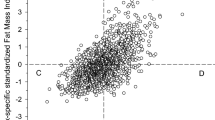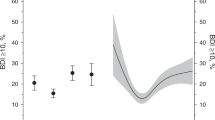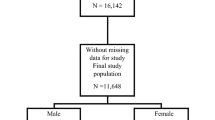Abstract
The mechanisms and temporal sequence underlying the association between major depressive disorder (MDD) and cardio-metabolic diseases are still poorly understood. Recent research suggests subtyping depression to study the mechanisms underlying its association with biological correlates. Accordingly, our aims were to (1) assess the prospective associations of the atypical, melancholic and unspecified subtypes of MDD with changes of fasting glucose, high-density lipoprotein-cholesterol, triglycerides, systolic blood pressure and the incidence of the metabolic syndrome, (2) determine the potential mediating role of inflammatory marker or adipokine concentrations, eating behaviors and changes in waist circumference during follow-up. Data stemmed from CoLaus|PsyCoLaus, a prospective cohort study including 35–66-year-old randomly selected residents of an urban area. Among the Caucasian participants who underwent the physical and psychiatric baseline evaluations, 2813 (87% participation rate) also accepted the physical follow-up exam (mean follow-up duration=5.5 years). Symptoms of mental disorders were elicited using a semi-structured interview. The atypical MDD subtype, and only this subtype, was prospectively associated with a higher incidence of the metabolic syndrome (OR=2.49; 95% CI 1.30–4.77), a steeper increase of waist circumference (β=2.41; 95% CI 1.19–3.63) and independently of this, with a steeper increase of the fasting glucose level (β=131; 95% CI 38–225) during follow-up. These associations were not attributable to or mediated by inflammatory marker or adipokine concentrations, eating behaviors, comorbid psychiatric disorders or lifestyle factors. Accordingly, our results further support the subtyping of MDD and highlight the particular need for prevention and treatment of metabolic consequences in patients with atypical MDD.
This is a preview of subscription content, access via your institution
Access options
Subscribe to this journal
Receive 12 print issues and online access
$259.00 per year
only $21.58 per issue
Buy this article
- Purchase on Springer Link
- Instant access to full article PDF
Prices may be subject to local taxes which are calculated during checkout

Similar content being viewed by others
References
Van der Kooy K, van Hout H, Marwijk H, Marten H, Stehouwer C, Beekman A . Depression and the risk for cardiovascular diseases: systematic review and meta analysis. Int J Geriatr Psychiatry 2007; 22: 613–626.
Nicholson A, Kuper H, Hemingway H . Depression as an aetiologic and prognostic factor in coronary heart disease: a meta-analysis of 6362 events among 146 538 participants in 54 observational studies. Eur Heart J 2006; 27: 2763–2774.
Huffman JC, Celano CM, Beach SR, Motiwala SR, Januzzi JL . Depression and cardiac disease: epidemiology, mechanisms, and diagnosis. Cardiovasc Psychiatry Neurol 2013; 2013: 695925.
Baune BT, Stuart M, Gilmour A, Wersching H, Arolt V, Berger K . Moderators of the relationship between depression and cardiovascular disorders: a systematic review. Gen Hosp Psychiatry 2012; 34: 478–492.
Penninx BW, Milaneschi Y, Lamers F, Vogelzangs N . Understanding the somatic consequences of depression: biological mechanisms and the role of depression symptom profile. BMC Med 2013; 11: 129.
Clair C, Rigotti NA, Porneala B, Fox CS, D'Agostino RB, Pencina MJ et al. Association of smoking cessation and weight change with cardiovascular disease among adults with and without diabetes. JAMA 2013; 309: 1014–1021.
Luppino FS, de Wit LM, Bouvy PF, Stijnen T, Cuijpers P, Penninx BW et al. Overweight, obesity, and depression: a systematic review and meta-analysis of longitudinal studies. Arch Gen Psychiatry 2010; 67: 220–229.
Mezuk B, Eaton WW, Albrecht S, Golden SH . Depression and type 2 diabetes over the lifespan: a meta-analysis. Diabetes Care 2008; 31: 2383–2390.
Knol MJ, Twisk JW, Beekman AT, Heine RJ, Snoek FJ, Pouwer F . Depression as a risk factor for the onset of type 2 diabetes mellitus. A meta-analysis. Diabetologia 2006; 49: 837–845.
Nouwen A, Winkley K, Twisk J, Lloyd CE, Peyrot M, Ismail K et al. Type 2 diabetes mellitus as a risk factor for the onset of depression: a systematic review and meta-analysis. Diabetologia 2010; 53: 2480–2486.
Scott D, Happell B . The high prevalence of poor physical health and unhealthy lifestyle behaviours in individuals with severe mental illness. Issues Mental Health Nurs 2011; 32: 589–597.
Vancampfort D, Correll CU, Wampers M, Sienaert P, Mitchell AJ, De Herdt A et al. Metabolic syndrome and metabolic abnormalities in patients with major depressive disorder: a meta-analysis of prevalences and moderating variables. Psychol Med 2013; 44: 1–12.
Pan A, Keum N, Okereke OI, Sun Q, Kivimaki M, Rubin RR et al. Bidirectional association between depression and metabolic syndrome: a systematic review and meta-analysis of epidemiological studies. Diabetes Care 2012; 35: 1171–1180.
Goldbacher EM, Bromberger J, Matthews KA . Lifetime history of major depression predicts the development of the metabolic syndrome in middle-aged women. Psychosom Med 2009; 71: 266–272.
Antonijevic IA . Depressive disorders – is it time to endorse different pathophysiologies? Psychoneuroendocrinology 2006; 31: 1–15.
Ghaemi SN, Vohringer PA . The heterogeneity of depression: an old debate renewed. Acta Psychiatr Scand 2011; 124: 497.
Baune BT, Stuart M, Gilmour A, Wersching H, Heindel W, Arolt V et al. The relationship between subtypes of depression and cardiovascular disease: a systematic review of biological models. Transl Psychiatry 2012; 2: e92.
Harald B, Gordon P . Meta-review of depressive subtyping models. J Affect Disord 2012; 139: 126–140.
Kaestner F, Hettich M, Peters M, Sibrowski W, Hetzel G, Ponath G et al. Different activation patterns of proinflammatory cytokines in melancholic and non-melancholic major depression are associated with HPA axis activity. J Affect Disord 2005; 87: 305–311.
Cizza G, Ronsaville DS, Kleitz H, Eskandari F, Mistry S, Torvik S et al. Clinical subtypes of depression are associated with specific metabolic parameters and circadian endocrine profiles in women: the power study. PLoS One 2012; 7: e28912.
Glaus J, Vandeleur C, Gholam-Rezaee M, Castelao E, Perrin M, Rothen S et al. Atypical depression and alcohol misuse are related to the cardiovascular risk in the general population. Acta Psychiatr Scand 2013; 128: 282–293.
Lamers F, Vogelzangs N, Merikangas KR, de Jonge P, Beekman AT, Penninx BW . Evidence for a differential role of HPA-axis function, inflammation and metabolic syndrome in melancholic versus atypical depression. Mol Psychiatry 2013; 18: 692–699.
Vogelzangs N, Comijs HC, Oude Voshaar RC, Stek ML, Penninx BW . Late-life depression symptom profiles are differentially associated with immunometabolic functioning. Brain Behav Immun 2014; 41: 109–115.
Takeuchi T, Nakao M, Kachi Y, Yano E . Association of metabolic syndrome with atypical features of depression in Japanese people. Psychiatry Clin Neurosci 2013; 67: 532–539.
Lasserre AM, Glaus J, Vandeleur CL, Marques-Vidal P, Vaucher J, Bastardot F et al. Depression with atypical features and increase in obesity, body mass index, waist circumference, and fat mass: a prospective, population-based study. JAMA Psychiatry 2014; 71: 880–888.
Lamers F, Beekman AT, van Hemert AM, Schoevers RA, Penninx BW . Six-year longitudinal course and outcomes of subtypes of depression. Br J Psychiatry 2016; 208: 62–68.
Yoon HK, Kim YK, Lee HJ, Kwon DY, Kim L . Role of cytokines in atypical depression. Nordic J Psychiatry 2012; 66: 183–188.
Rudolf S, Greggersen W, Kahl KG, Huppe M, Schweiger U . Elevated IL-6 levels in patients with atypical depression but not in patients with typical depression. Psychiatry Res 2014; 217: 34–38.
Kop WJ, Stein PK, Tracy RP, Barzilay JI, Schulz R, Gottdiener JS . Autonomic nervous system dysfunction and inflammation contribute to the increased cardiovascular mortality risk associated with depression. Psychosom Med 2010; 72: 626–635.
Ross R . Atherosclerosis—an inflammatory disease. N Engl J Med 1999; 340: 115–126.
Lu XY . The leptin hypothesis of depression: a potential link between mood disorders and obesity? Curr Opin Pharmacol 2007; 7: 648–652.
Milaneschi Y, Lamers F, Bot M, Drent ML, Penninx BW . Leptin dysregulation is specifically associated with major depression with atypical features: evidence for a mechanism connecting obesity and depression. Biol Psychiatry 2015; pii: S0006-3223: 00951–00958.
Firmann M, Mayor V, Vidal PM, Bochud M, Pecoud A, Hayoz D et al. The CoLaus study: a population-based study to investigate the epidemiology and genetic determinants of cardiovascular risk factors and metabolic syndrome. BMC Cardiovasc Disord 2008; 8: 6.
Preisig M, Waeber G, Vollenweider P, Bovet P, Rothen S, Vandeleur C et al. The PsyCoLaus study: methodology and characteristics of the sample of a population-based survey on psychiatric disorders and their association with genetic and cardiovascular risk factors. BMC Psychiatry 2009; 9: 9.
Matthews DR, Hosker JP, Rudenski AS, Naylor BA, Treacher DF, Turner RC . Homeostasis model assessment: insulin resistance and beta-cell function from fasting plasma glucose and insulin concentrations in man. Diabetologia 1985; 28: 412–419.
Grundy SM, Cleeman JI, Daniels SR, Donato KA, Eckel RH, Franklin BA et al. Diagnosis and management of the metabolic syndrome: an American Heart Association/National Heart, Lung, and Blood Institute Scientific Statement. Circulation 2005; 112: 2735–2752.
Marques-Vidal P, Bochud M, Bastardot F, Luscher T, Ferrero F, Gaspoz JM et al. Levels and determinants of inflammatory biomarkers in a Swiss population-based sample (CoLaus study). PLoS One 2011; 6: e21002.
Hollingshead AB . Four factor Index of Social Status. Yale University Press: New Heaven, CT, 1975.
Bernstein L, Huot I, Morabia A . Amélioration des performances d'un questionnaire alimentaire semi-quantitatif comparé à un rappel des 24 heures. Santé Publique 1995; 7: 403–413.
Beer-Borst S, Costanza MC, Pechere-Bertschi A, Morabia A . Twelve-year trends and correlates of dietary salt intakes for the general adult population of Geneva, Switzerland. Eur J Clin Nutr 2009; 63: 155–164.
Nurnberger JI Jr, Blehar MC, Kaufmann CA, York-Cooler C, Simpson SG, Harkavy-Friedman J et al. Diagnostic interview for genetic studies. Rationale, unique features, and training. NIMH Genetics Initiative. Arch Gen Psychiatry 1994; 51: 849–859.
Preisig M, Fenton BT, Matthey ML, Berney A, Ferrero F . Diagnostic interview for genetic studies (DIGS): inter-rater and test-retest reliability of the French version. Eur Arch Psychiatry Clin Neurosci 1999; 249: 174–179.
Endicott J, Spitzer RL . A diagnostic interview: the schedule for affective disorders and schizophrenia. Arch Gen Psychiatry 1978; 35: 837–844.
American Psychiatric Association Task Force on DSM-IV. DSM-IV-TR: Diagnostic And Statistical Manual Of Mental Disorders. 4th edn, text revision edn. American Psychiatric Association: Washington, DC, USA, 2000; XXXVII: 943.
Morin AJ, Moullec G, Maiano C, Layet L, Just JL, Ninot G . Psychometric properties of the Center for Epidemiologic Studies Depression Scale (CES-D) in French clinical and nonclinical adults. Rev Epidemiol Sante Publique 2011; 59: 327–340.
Radloff LS . The CES-D scale: a self-report depression scale for research in the general population. Appl Psychol Measurement 1977; 1: 385–401.
Huber P . Robust regression: asymptotics, conjectures and monte carlo. Ann Stat 1973; 1: 799–821.
Licht CM, de Geus EJ, Penninx BW . Dysregulation of the autonomic nervous system predicts the development of the metabolic syndrome. J Clin Endocrinol Metab 2013; 98: 2484–2493.
MICROMEDEX® 1.0 (Healthcare series). Thomson Reuters.Copyright© 1974-2011. Greenwood Village, CO. Available at: http://www.micromedex.com. Accessed on November 15, 2011.
Compendium Suisse de Médicaments, vol. 31. e Documed S.A.: Bâle (Suisse), 2010, 3-A 5257pp.
Milaneschi Y, Lamers F, Mbarek H, Hottenga JJ, Boomsma DI, Penninx BW . The effect of FTO rs9939609 on major depression differs across MDD subtypes. Mol Psychiatry 2014; 19: 960–966.
Rivera M, Cohen-Woods S, Kapur K, Breen G, Ng MY, Butler AW et al. Depressive disorder moderates the effect of the FTO gene on body mass index. Mol Psychiatry 2012; 17: 604–611.
Samaan Z, Garasia S, Gerstein HC, Engert JC, Mohan V, Diaz R et al. Lack of association between type 2 diabetes and major depression: epidemiologic and genetic evidence in a multiethnic population. Transl Psychiatry 2015; 5: e618.
Scherrer JF, Xian H, Lustman PJ, Franz CE, McCaffery J, Lyons MJ et al. A test for common genetic and environmental vulnerability to depression and diabetes. Twin Res Hum Genet 2011; 14: 169–172.
Acknowledgements
We express our gratitude to the Lausanne inhabitants who volunteered to participate in the CoLaus|PsyCoLaus study. We thank all the investigators of the study. The CoLaus|PsyCoLaus study was and is supported by research grants from GlaxoSmithKline, the Faculty of Biology and Medicine of Lausanne, and the Swiss National Science Foundation (grants 3200B0–105993, 3200B0-118308, 33CSCO-122661, 33CS30-139468 and 33CS30-148401). Aurélie Lasserre is supported by a grant from the Swiss National Science Foundation (grant 323530_151479).
Author information
Authors and Affiliations
Corresponding author
Ethics declarations
Competing interests
The authors declare no conflict of interest.
PowerPoint slides
Rights and permissions
About this article
Cite this article
Lasserre, A., Strippoli, MP., Glaus, J. et al. Prospective associations of depression subtypes with cardio-metabolic risk factors in the general population. Mol Psychiatry 22, 1026–1034 (2017). https://doi.org/10.1038/mp.2016.178
Received:
Revised:
Accepted:
Published:
Issue Date:
DOI: https://doi.org/10.1038/mp.2016.178
This article is cited by
-
Metabolomics signatures of depression: the role of symptom profiles
Translational Psychiatry (2023)
-
Liposaccharide-induced sustained mild inflammation fragments social behavior and alters basolateral amygdala activity
Psychopharmacology (2023)
-
Evaluation of inflammatory and metabolic impairments regarding depression dimensions: a case control study
Middle East Current Psychiatry (2022)
-
The association between dietary insulin index and load with mental health
BMC Psychology (2022)
-
Inflammation and depression in young people: a systematic review and proposed inflammatory pathways
Molecular Psychiatry (2022)



